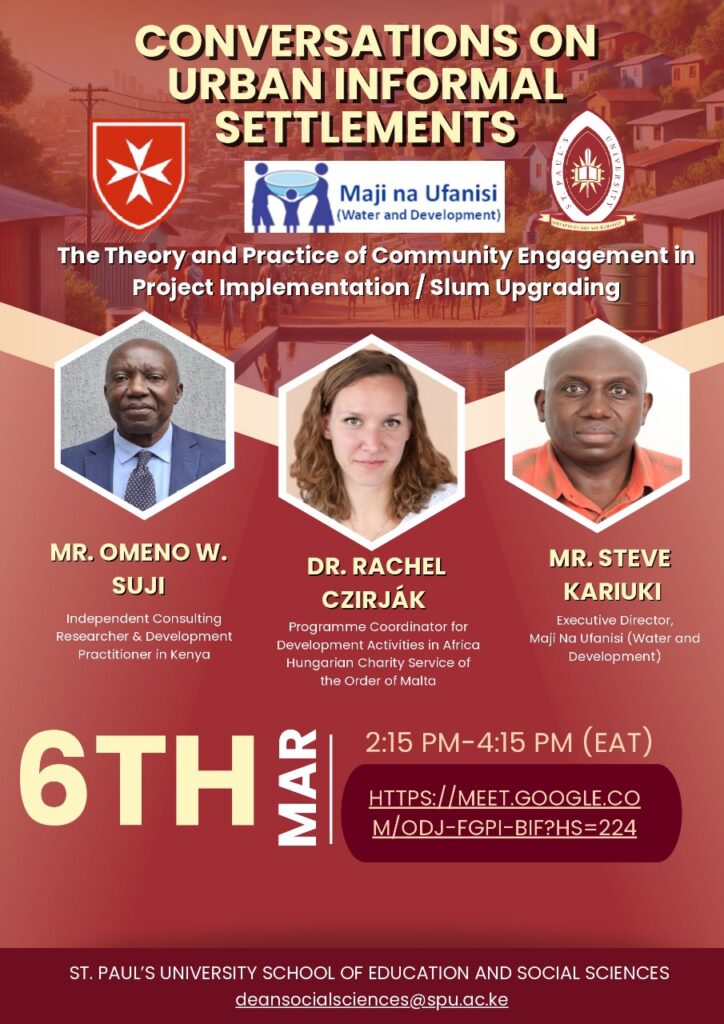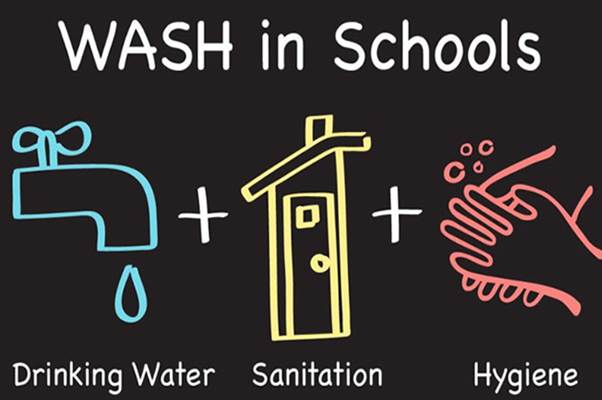Insights from a Groundbreaking Webinar on Theory and Practice of Community Engagement

Urban informal settlements—or slums—are often perceived as chaotic spaces rife with poverty, inadequate services, and environmental hazards. Yet, they are also vibrant communities full of human potential. A recent webinar hosted by St. Paul’s University, featuring field experts from Maji na Ufansi and the Hungarian Charity Service of the Order of Malta, examined a key question in development practice: how can genuine community engagement turn informal settlements into models of sustainable development?
The event, which focused on the Kibera slum upgrading project in Nairobi, Kenya, explored the intersection of theory and practice in participatory development. Panelists unpacked lessons, frameworks, and real-world implementation challenges, offering a roadmap for replicable, inclusive urban transformation.
Theoretical Foundations: Participation Beyond Tokenism
Dr. Rachel, Head of International Development at Hungary Helps, introduced the theory of participatory development, focusing on the widely cited Arnstein’s Ladder of Participation. This framework illustrates levels of citizen engagement in decision-making, from manipulation and tokenism at the bottom to full citizen control at the top.
Key distinctions were made between:
- Non-participation (e.g., manipulation, therapy),
- Tokenism (informing, consultation, placation),
- Citizen power (partnership, delegated power, citizen control).
True community-led development begins at the partnership level—where communities and implementers share decision-making authority. Any development project falling below this threshold is considered insufficient in empowering the target population.
Why Many Development Projects Fail in Slums
Panelist Omeno Suji highlighted how many well-funded slum projects fail due to poor stakeholder alignment. Often, donors and government agencies design projects without adequate input from the people they aim to serve. This results in mismatched priorities, poor uptake, and low sustainability.
Some common pitfalls include:
- Treating communities as beneficiaries rather than co-creators,
- Relying on outdated data or assumptions,
- Ignoring the complex political economy of slum dynamics (e.g., absentee landlords, informal service providers),
- Underestimating the need for community buy-in.
Case Study: The Kibera Slum Upgrading Project
Steven Karuki, Executive Director of Maji na Ufanisi, shared a compelling case study of the Kibera Water and Sanitation Project, part of the larger Kenya Slum Upgrading Programme (KENSUP).
Implemented between 2007 and 2012, the project aimed to:
- Upgrade 2.5 km of low-volume roads,
- Construct 1.8 km of stormwater drains,
- Improve footbridges and sanitation facilities,
- Build a community resource center,
- Engage residents in waste management and hygiene training.
But what made this project different from previous failures? Deep, structured community participation.
Community Involvement: More Than a Checkbox
From the outset, Maji na Ufanisi emphasized extensive needs assessment through consultations, focus groups, and interviews. Multiple community governance structures were formed, including:
- Settlement Executive Committee (SEC) – overseeing general project engagement,
- Facility Management Groups – handling operation and maintenance,
- Road Relocation Committees – facilitating consensual land use changes.
These bodies allowed for participatory planning, continuous feedback, and local capacity-building—ensuring that the project wasn’t just for the community but by the community.
Success Factors in the Kibera Model
Key success factors that led to sustainable impact included:
- Ownership through design input: Communities helped design water kiosks and toilet blocks.
- Economic sustainability: Sanitation facilities operated on a pay-per-use model, generating revenue for maintenance and expansion.
- Inclusivity: Women, youth, and people with disabilities were required participants in planning forums.
- Local labor: Skilled and unskilled work was sourced from within the community.
- Long-term partnerships: Continued collaboration between NGOs, governments, and academia reinforced credibility.
Challenges Encountered and Overcome
Despite its success, the project faced hurdles:
- Land tenure complexity: Many structures in Kibera are owned by powerful external stakeholders.
- Engineering limitations: Slum topography and unregulated waste dumping complicated construction.
- Sociopolitical dynamics: Resistance from informal service vendors (e.g., water sellers) was common.
Yet, because of negotiated engagement and strong local structures, most issues were resolved amicably and inclusively.
Policy Impact and Legacy
The Kibera project didn’t just improve infrastructure—it shaped policy:
- Informed Kenya’s 2010 Constitution on public participation and housing rights,
- Influenced eviction guidelines emphasizing humane, rights-based approaches,
- Contributed to the Affordable Housing Program under Kenya’s Big Four Agenda,
- Demonstrated a replicable model now used in settlements like Bangladesh in Mombasa.
Academic Opportunities: Research, Monitoring, and Innovation
The webinar emphasized that academic institutions can fill vital knowledge gaps in development projects. Opportunities include:
- Research partnerships for impact assessments and policy analysis,
- Student internships for hands-on learning,
- Knowledge documentation for sustainability and donor reporting.
St. Paul’s University was invited to be part of this ecosystem by anchoring knowledge creation and dissemination, helping to ensure that development gains are not lost over time.
From Projects to Partnerships
The main lesson from the webinar was clear: development without deep, structured, and equitable community participation is unlikely to succeed. The Kibera project offers a tangible model for how slum upgrading can work when community members are not just participants—but co-owners of the process.
To scale such models, we need:
- Flexible funding,
- Strong local partnerships,
- Thoughtful academic involvement,
- And above all, a shift in mindset—from charity to empowerment.
10 Frequently Asked Questions (FAQs)
1. What was the main focus of the webinar?
The webinar centered on the theory and practice of community engagement, using the Kibera slum upgrading project as a case study.
2. Who organized the webinar?
It was organized by St. Paul’s University in collaboration with development partners Majin Alfaisi and Hungary Helps.
3. What is Arnstein’s Ladder of Participation?
It’s a framework that illustrates levels of citizen participation in development, from non-participation to full citizen control.
4. What made the Kibera project successful?
Its success was rooted in genuine community participation, clear governance structures, sustainable funding models, and inclusive design.
5. What are Facility Management Groups?
They are community-formed teams that manage sanitation and water facilities, handling maintenance, budgeting, and accountability.
6. How was the project funded?
The project was funded by UN-Habitat, World Bank Cities Alliance, and the Government of Kenya, with implementation by Majin Alfaisi.
7. Was there any resistance from the local community?
Yes, especially from absentee landlords and informal vendors, but structured engagement and negotiations helped resolve conflicts.
8. How is water supplied to the facilities?
Water is supplied by Nairobi Water Company through community meters, with some backup from private vendors and on-site storage.
9. What role can universities play in similar projects?
Universities can conduct research, support monitoring and evaluation, provide students for fieldwork, and help document success stories.
10. Is this model being used elsewhere in Kenya?
Yes, similar projects are now being implemented in Mombasa’s informal settlements like Bangladesh and Bombo, with encouraging results.


